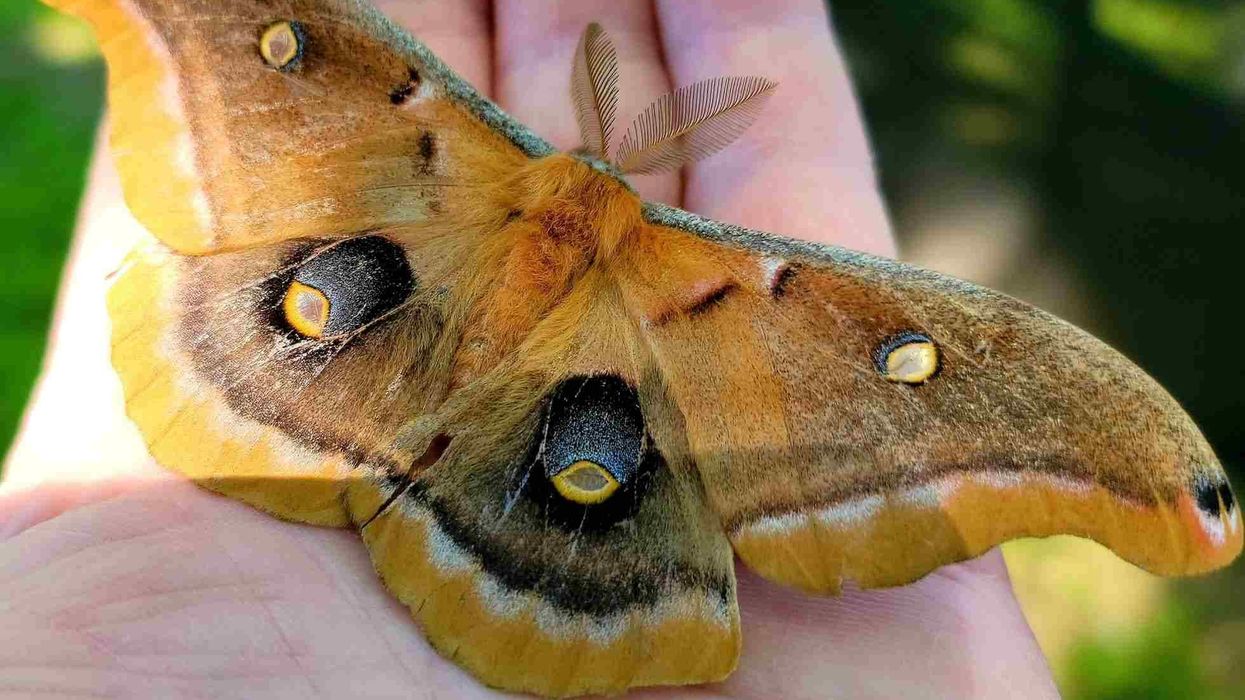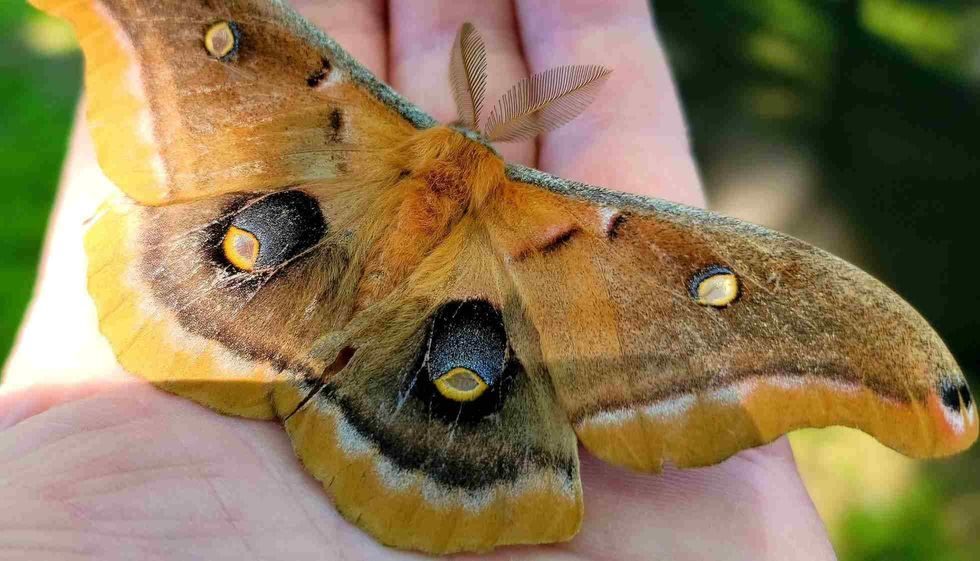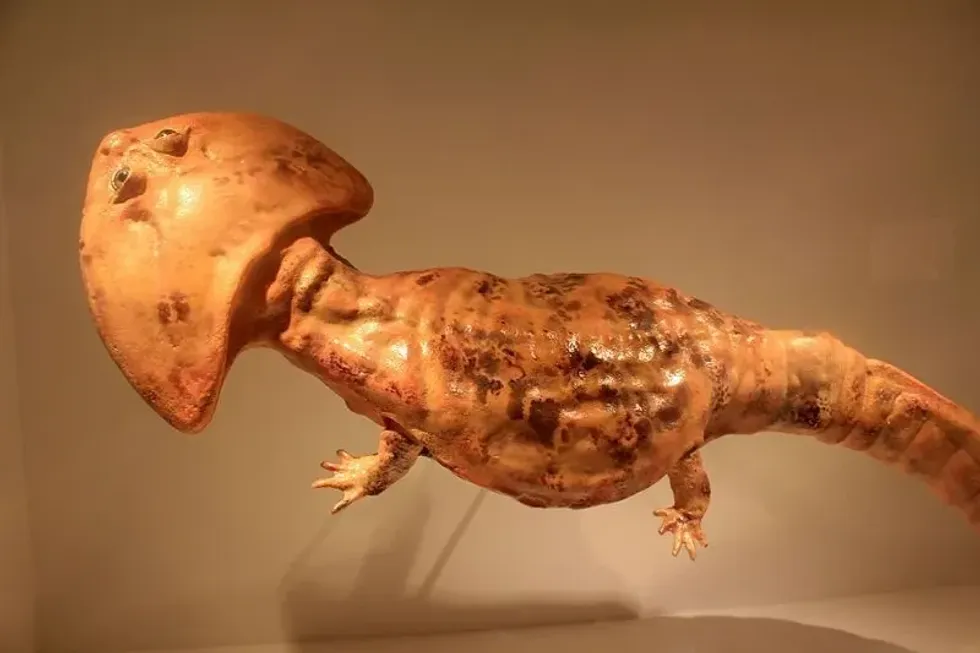One of the beautiful silk moths, the Polyphemus moth, belongs to the family of the largest species of moths, Saturniidae. The scientific name of the insect is Antheraea polyphemus and these moths are found in the North American continent primarily in countries such as Canada and the United States.
The credit for discovering the species goes to the Dutch entomologist, Pieter Cramer.
A Polyphemus moth is generally of tan or dark brown color. The average wingspan of Polyphemus moths is 4-6 in (10-15 cm) which is quite long compared to other silk moths.
Also, these moths are best known for the large purplish eyespots on their hind wings which help them to distract their predators. They also have antennas that help male moths to detect unmated female Polyphemus moths.
This insect generally eats birch, grapes, and leaf. The life cycle of Polyphemus moths is the same as other moths. They generally lay their eggs on different host plants and small yellow caterpillars come out of their eggs.
Also, their eggs and caterpillars are light brown. Keep on reading to learn more interesting facts about Polyphemus moths.
If you want to know more exciting information about different animals, check out the American dagger moth and gypsy moth.
Polyphemus Moth Interesting Facts
What type of animal is a Polyphemus Moth?
Polyphemus moths are silk moths and can easily be found in tan and brown colors. These insects are known for their distinct mechanism to confuse or distract their predators. These moths are generally quite large.
What class of animal does a Polyphemus Moth belong to?
A Polyphemus moth belongs to the Insecta class and Antheraea genus. The moth belongs to the family of the largest silk moths, Saturniidae which are most prominent in the North American continent.
How many Polyphemus Moths are there in the world?
The exact population of the Polyphemus moths is scientifically unknown as of now but these insects are majorly found in the countries of North America. A recent study suggests that the population of moths is falling in a few parts of Canada.
Where does a Polyphemus Moth live?
A Polyphemus moth is found in various countries of North America. The numbers of these insects are quite huge in the United States whereas in Canada they can easily be found in except for a few provinces such as Prince Edward Island, and Newfoundland.
What is a Polyphemus Moth's habitat?
The Polyphemus moth habitat is usually found in subarctic regions. We can also find these insects in forests, and swamps. As they prey on plants, many of the species can easily be spotted in agricultural fields.
Who do Polyphemus Moths live with?
This insect does not live in groups and is solitary. Also, the moths are quite active during dusk, and only during the mating season do the male and female Polyphemus moths come together.
How long does a Polyphemus Moth live?
The average life cycle of Polyphemus moths can be up to three months but when they turn adult, the moths generally live for around three to four days. These moths spend around 10 days as eggs, after more than five weeks as larvae, and around 20-24 days as pupae as caterpillars.
The Polyphemus moth's lifespan can also increase if these insects survive the winter season.
How do they reproduce?
The mating system followed by the Polyphemus moths is polygynous which means the male moths mate with numerous females while the female moths only mate with a single male. Also, the antennae of male moths help them to detect the pheromones or chemicals released by the female Polyphemus moths.
When the caterpillars come out of the Polyphemus moth cocoon, the mating process starts on the same day.
These moths generally mate after the afternoon and can even last for several hours. Female moths lay eggs right after the mating ends.
They usually mate in the spring season and lay eggs on leaves of trees and shrubs, and on average, a female lays around three to five eggs. The Polyphemus moth eggs are yellow or light brown.
Their eggs are even quite big than some of the moths and are 0.11 in (3 mm) in diameter and 0.049 in (1.25 mm) thick.
In various regions, the mating takes place twice a year, once in early spring and the other in the summer season while in the north, the United States, and Canada, the species mate only once a year. Also, if females fail to find a partner, they release their unfertilized eggs.
What is their conservation status?
As of now, we do not have any information regarding the conservation status of the species as many organizations such as the Internation Union for Conservation of Nature, CITES, and many more have not evaluated the status. A study also shows that the numbers of the species are sinking steadily in some parts of Canada.
Polyphemus Moth Fun Facts
What do Polyphemus Moths look like?
Polyphemus moths are adorable moths and also giant in size. If you look they have hind wings with purplish eyespots. The eyespot helps them to get rid of the predators.
With the help of these hind wings, they mimic birds which helps them to distract bigger insects and birds. The Polyphemus moths have two antennae. The adult male moths primarily use their antennae to detect the pheromones released by the female moths.
There is a slight difference between the Polyphemus moth male vs female. Males generally have hairy antennae while females have thinner antennae.
Females have thin antennas as compared to males. These moths are found in a variety of colors such as tan, reddish-brown, and dark brown. You can easily spot these moths in countries such as the United States, Canada, and other parts of North America.

How cute are they?
The Polyphemus moth is an adorable silk moth and is found in tan, reddish-brown, and dark brown colors. The most beautiful characteristic of the species is their hindwings which have two black or blue-lined eye spots and also have long and bushy antennae.
These moths are quite large and their wingspan can be up to 4-6 in (10-15 cm) long. From being larvae when they are bright green to turning into an adult, this insect never fails to fascinate people with their beauty.
How do they communicate?
The Polyphemus moths follow the same method of communication as other insects. They use vibrations, and body movement while communicating.
The male insects generally use the antennae to find the females while the female releases pheromones to send signals. Through the help of a sense of smell and the ability to touch, these insects try to communicate and find each other.
How big is a Polyphemus Moth?
As we know that these moths belong to the family of huge Saturniidae moths, it is very obvious that the body size of the insects would be large. The average size of a Polyphemus moth is 4-6 in (10-15 cm) and is 50 times bigger than the moth native to Mexico, known as Stigmella Maya.
Also, Polyphemus moths are three times bigger than domestic silk moths.
How fast can Polyphemus Moths move?
Generally, the exact speed of Polyphemus moths is being studied by scientists but these insects are indeed quite active during the night. Also, the speed of these moths is determined by the speed of the wind, and with a flow of jets, these moths can attain a speed of more than 50 mph (80 kph).
How much does a Polyphemus Moth weigh?
The accurate weight of the species is not known but they are quite larger than many of the moths such as common cloth moths, domestic silk moths, luna moths, Indian meal moths, and many more. Now we can get some idea of the weight of the species.
What are the male and female names of the species?
There are no specific names given to the male and female moth species. People generally refer to them as male Polyphemus moth and female Polyphemus moth.
What would you call a baby Polyphemus Moth?
No particular name has been given to refer to a baby Polyphemus moth but when the moth is in the early stages, it is called larvae. After that, it becomes a pupa before turning into an adult.
What do they eat?
Primarily, the Polyphemus moth diet is the leaves of different trees and shrubs. They also prey on birch, grapes, maple, and sweetgums. Many studies also suggest that the larvae also prey on the shells of the egg and the newly removed skin.
Are they harmful?
Many of the species of moths can bite and also have stings but the Polyphemus moths are not at all harmful. The adult moth is quite large but they generally avoid human interaction and are solitary.
But a few of the cases show that the Polyphemus moths can cause allergies to humans and the larvae of the insects are also poisonous and can cause deaths.
Would they make a good pet?
These insects are one of the most beautiful creatures on the planet and many people often keep them as pets. Also, their eating habits are quite normal and they generally eat the leaves of plants and trees. But this large brown moth belongs to nature and it would not be easy for these insects to change their habitat.
Did you know...
An interesting fact about the Polyphemus moth is that the caterpillar of the species eats so much and a study also reveals that it can eat more than 86,000 times its weight. Also, when they turn into an adult, the size of their mouths decreases gradually.
As we know that the Polyphemus moth is best known for distracting different insects and birds. These moths look similar to the great horned owl, also known as the tiger owl of the United States.
Polyphemus Moth Caterpillar vs Luna Moth Caterpillar
Like the Polyphemus moths, the Luna moths belong to the same giant moth family of Saturniidae, and both species are found in countries such as the United States and Canada and other parts of North America as well.
Also, both of the species are solitary, nocturnal, prey on the leaves of the plant and trees, and their habitat is almost the same.
It is not that easy to differentiate both species but there are several factors on which we can differentiate both.
If you look closely, the head of both the caterpillars is different, the head of Polyphemus moth caterpillars are brown while Luna moth caterpillars have green head. Also, the former has yellow horizontal lines on their body whereas the latter one has vertical lines on the body.
All about Polyphemus Moth cocoons
The entire life cycle of a Polyphemus moth is of three months which is divided into multiple stages.
Generally, most of the most come out of the cocoon in around 18-21 days but it takes 10 days while these species are in the egg, more than five weeks as larvae.
After that caterpillars wrap their body in leaves and make cocoons with the help of silk and the pupae stage ranges from 12-14 days after which these insects come out of their cocoons after the winter season.
The caterpillars eat the leaf on which they dwell.
Here at Kidadl, we have carefully created lots of interesting family-friendly animal facts for everyone to discover! Learn more about some other arthropods including the puss moth or bombardier beetle.
You can even occupy yourself at home by drawing one on our Polyphemus Moth coloring pages.










